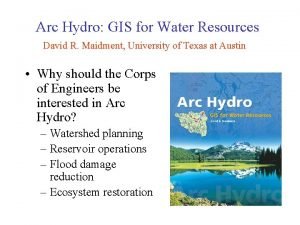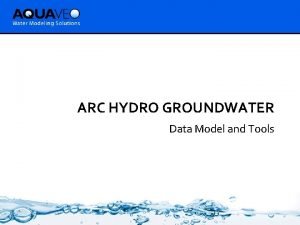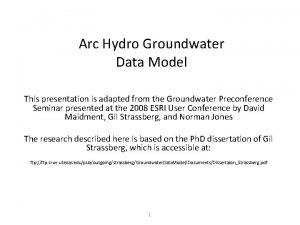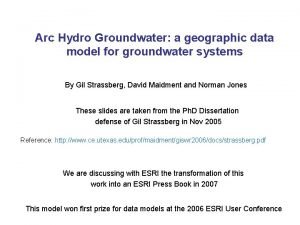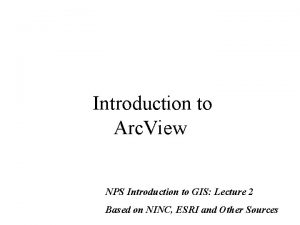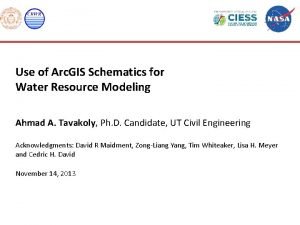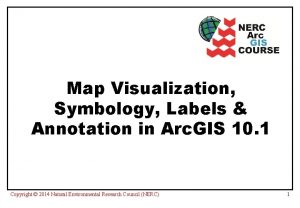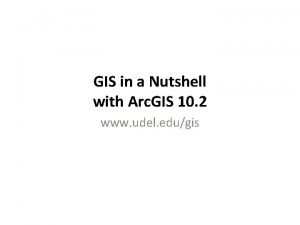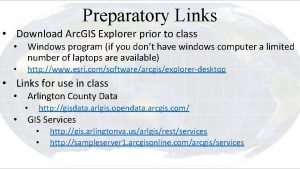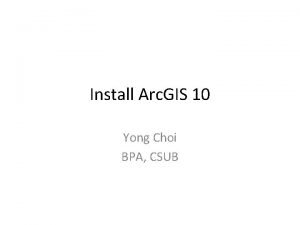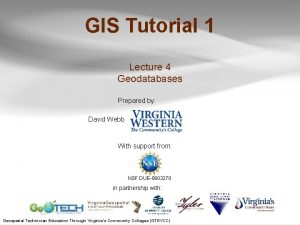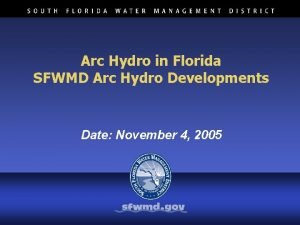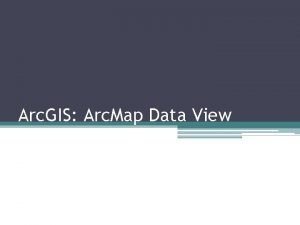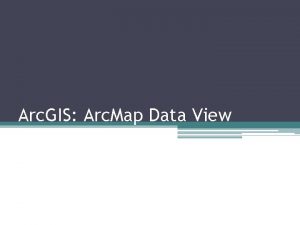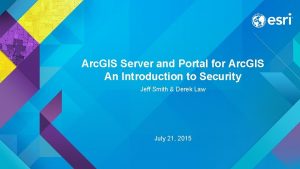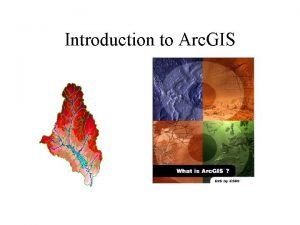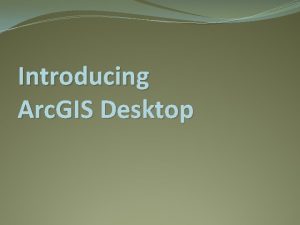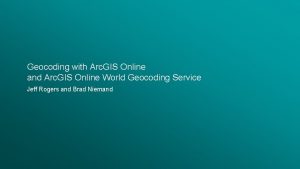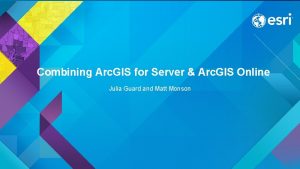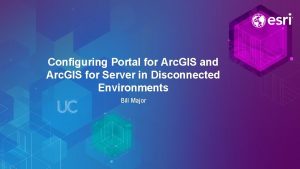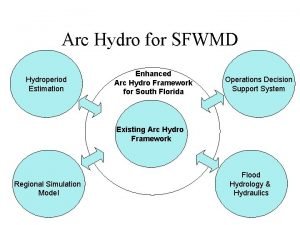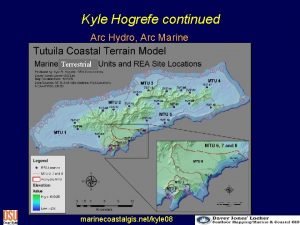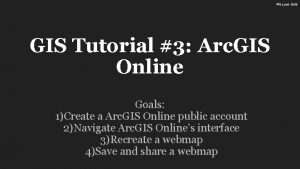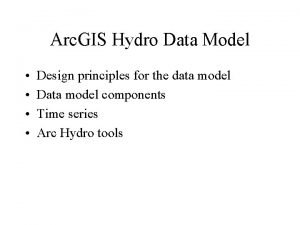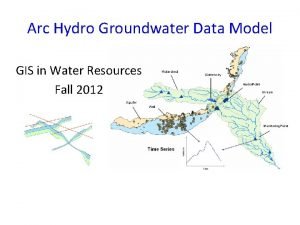Arc GIS tutorial Tutorial Copyright Hydro ASIA 2018


















- Slides: 18

Arc. GIS tutorial Tutorial Copyright © Hydro. ASIA 2018

Title of section • What is Arc. GIS? Arc. GIS is a geographic information system (GIS) for working with maps and geographic information. This platform can be used to apply geography for solving problems and making decision. Spatial analysis allows to understand spatial relationships and patterns. With Arc. GIS we can build maps using up-to-date data, perform deep analysis, and share our results • Data in Arc. GIS • Components of Arc. GIS: Arc. Map, Arc. Catalog and Arc. Toolbox • Extensions of Arc. GIS: Spatial Analyst and Arc. Hydro

Data in Arc. GIS • Geodatabases & Geographic data models A geographic data model is a structure for organizing geospatial data so that it can be easily stored and retrieved: Vector or Raster The geodatabase is a “container” used to hold a collection of datasets ü File Geodatabase (. gdb) ü Personal Geodatabase (. mdb) Workspace Geodatabase Feature Dataset Shape

Data in Arc. GIS • Arc. GIS presents two kinds of geographic data models: Vector & Raster Vector ü ü Points Lines Polygons Annotation Raster: consists of a matrix of cells (or pixels) organized into rows and columns (or a grid)

Tutorial STEP 1 • Open Arc. Map and créate a new Project. • Go to File -> New -> Blank Map • Go to Customize -> Extensions Make sure the “Spatial Analyst” tool is activated. • Go to Customize -> Toolbars Make sure “Arc Hydro Tools” is activated. • Now you can start using your “Arc. Hydro” tool in your case study.

Tutorial STEP 2 • Open Arc. Catalog. Click the button “Connect to Folder” and select the folder that contains the layers that will be used. • Go to Arc. Map. Click the button “Add Data” to add the topography data into Arc. Map. • Select the dem file: dem_tm This file is the DEM of all South Korea.

Tutorial STEP 3 • Check the spatial reference of the layer. If it doesn’t have one, give it by yourself. • To check it go to View -> Data Frame Properties. Make sure Tokyo_Transverse_Mercator is selected, if not: • Go to “Arc. Catalog”. Right click the layer. Select Properties. Under General, go to Spatial Reference. Click Edit. • Click Select to select a predefined coordinate system. Select Tokyo_Transverse_Mercator

Tutorial GOOGLE EARTH • The coordinate system can be checked using Google Earth. The GIS function can be used to export the layer to Google Earth. • Activate the Arc. Toolbox. Open the Conversion Tools -> To KML -> Layer to KML. • After you’ve exported the layer to a KML file you can open it in Google Earth to check if the study area is at the correct location or not.

Tutorial STEP 4: EXTRACT BY MASK • Go to Add Data. Under the folder catchment select the file catchment. shp and add it. • Go to the Arc. Toolbox -> Spatial Analyst Tools -> Extraction -> Extract by Mask • Select the following: Input raster: dem_tm Input raster or feature mask data: catchment Output raster: save it as catchment_dem

Tutorial STEP 5: FILL THE SINK • The sinks of the data need to be filled in order to smooth of the topography to automatically remove “holes” from the measurement error. • Go to the Arc. Hydro tool -> Terrain Preprocessing -> DEM Manipulation -> Fill Sinks • Activate the Use Is. Sink Field and click OK.

Tutorial STEP 6: FLOW DIRECTION MAP • Go to Terrain Preprocessing -> Flow Direction • Select te Fil layer as input in the Hydro DEM.

Tutorial STEP 7: FLOW ACCUMULATION MAP • Go to Terrain Preprocessing -> Flow Accumulation • Select te Fdr layer as input in the Flow Direction Grid.

Tutorial STEP 8: DRAINAGE LINE DEFINITION • Go to Terrain Preprocessing -> Stream Definition • The user can define the calculation scale by “Number of cells” or “Area”. Choose an Area of 5. • Go to Terrain Preprocessing -> Stream Segmentation

Tutorial STEP 8: DRAINAGE LINE DEFINITION • Go to Terrain Preprocessing -> Drainage Line Processing, the drainage line in the catchment will be generated automatically based on the layer created before.

Tutorial STEP 9: CATCHMENT GRID DELINEATION • Go to Terrain Preprocessing -> Catchment Grid Delineation

Tutorial STEP 10: EXPORT THE CATCHMENT • Go to Terrain Preprocessing -> Catchment Polygon Processing

Tutorial STEP 11: DEFINE THE DRAINAGE POINTS • Go to Terrain Preprocessing -> Drainage Line Processing • Go to Customize -> Extensions • Activate the “Editor” toobox. • Click Editor -> Start Editing • Select the layer “Drainagepoint” • Select the points we won’t take into account and right click your mouse to choose “Delete”.

Tutorial STEP 12: DEFINE THE FINAL SUB-CATCHMENT • Go to Search: • Search for “snap pour points”. Use “Drainagepoint” and “Fac” as the two main inputs. • Search for “watershed”. Use “Fdr” and “Snap. Pou_” as the two main inputs.
 Fish map
Fish map Arc hydro groundwater
Arc hydro groundwater Arc hydro groundwater
Arc hydro groundwater Arc hydro groundwater
Arc hydro groundwater Arc view gis
Arc view gis Arc gis
Arc gis Arc gis map
Arc gis map Gis
Gis Arc gis
Arc gis Arc gis explorer
Arc gis explorer Arc gis 10
Arc gis 10 Arc promoteur vs arc investigateur
Arc promoteur vs arc investigateur Minor segment of a circle
Minor segment of a circle Major and minor arcs
Major and minor arcs Arc emu88 com arc info 09 100009 html
Arc emu88 com arc info 09 100009 html Copyright © 2018
Copyright © 2018 Copyright © 2018 all rights reserved
Copyright © 2018 all rights reserved Que letra continua m v t m j
Que letra continua m v t m j Gis tutorial
Gis tutorial
